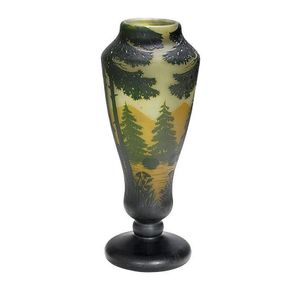Daum Nancy 'Berries' Cameo Glass Vase, French, 1915
You must be a subscriber, and be logged in to view price and dealer details.
Subscribe Now to view actual auction price for this item
When you subscribe, you have the option of setting the currency in which to display prices to $Au, $US, $NZ or Stg.
- Etched - Glass decorated with an etched design, which is achieved through marking out the pattern, protecting the area that is not be etched, and then immersing the object in acid to dissolve the surface of the unprotected area. With some glass objects, such as cameo glass, there may be several layers of different coloured glass, and part of the top layer is dissolved leaving the bottom layer as the background. The longer the time of exposure of the object to acid, the deeper the etching.
The word etching is also sometimes used to describe another method of decoration, where wheel grinders were used decorate the surface, but this technique is usually known as engraving. - Acid Etched - Acid etching is often used on glass, metals, and stone to create decorative finishes or to prepare the surface for further treatment or coating. The process of acid etching involves applying an acidic solution, such as hydrochloric acid or nitric acid, to the surface of the material and allowing it to react with the surface. The acid etches away a thin layer of the material, creating a rough, uneven finish. Acid etching can be used to create a variety of different finishes, from a subtle matte finish to a more pronounced, textured finish.
- Circa - A Latin term meaning 'about', often used in the antique trade to give an approximate date for the piece, usually considered to be five years on either side of the circa year. Thus, circa 1900 means the piece was made about 1900, probably between 1895 and 1905. The expression is sometimes abbreviated to c.1900.
This item has been included into following indexes:
Visually similar items

A Daum Nancy landscape vase, circa 1910 in three colour cameo glass, the tapered body supported on a circular foot, cut and etched with trees in deep green against a yellow and orange landscape, signed in cameo 'Daum Nancy' with cross of Loraine 39 cm high

A Bohemian gilt decorated glass vase, early 20th century, the tapering slender vase to a flat spreading foot, with three applied trailing amber tadpoles and a flat spreading foot also in amber, profusely decorated with gilt paste scrolling motifs, height 2

Richard Parker, winged vase, gold with green stripe, 2003, 13 x 13 cm

Moorcroft, 'Black Bean' vase, 2007, designed by Kerry Goodwin, impressed and inscribed, Moorcroft, England, 2007, Kg, 20.5 cm high
